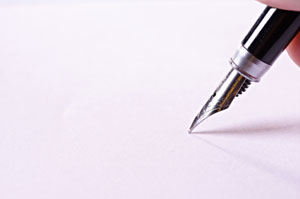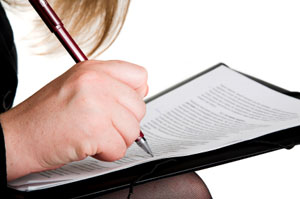The typical technical writing article addresses many aspects of technical writing including syntax, organization of information, and the use of graphics. However, one often overlooked aspect is the actual visual appearance of your documents. With a minimum of time investment, you can incorporate the following improvements in your documents. Technical writing seminars are well worth the time, but you can use some basic techniques to add professional polish to your writing.
Using White Space
Everyone would prefer reading a technical document that is visually appealing rather than one that is cluttered with dense copy and has little or no white space. Simply put, white space is blank space on the paper. It can be used for various techniques as well as an easy way to enhance your document's appearance.
White space can be used to achieve the following results:
- Frame the content
- Separate ideas
- Define sections of your document
- Provide relief from copy
- Highlight information
White space simultaneously "opens up" the document and segregates information into manageable segments. Your readers can digest a limited amount of information at one time. Think of white space as you would a five-course meal served in a four-star restaurant. Served in distinct courses, the food's visual impact is much greater than that of a crowded buffet table, which is laden with as much food as possible in as little space as possible.
You can achieve white space in the following ways:
- Before and after headings
- Wide margins on all four sides
- The space between columns of words or numbers
- Unjustified right margins
- Indented sentences
- Between paragraphs
- Bulleted items in a list
You may already be incorporating these techniques in your technical documents; however, if you are not, experiment with the ones you are not currently using. To see the difference between a document that appears crowded and dense with text and one that is open and visually appealing, compare a document that you have already written with the same document after you have enhanced it with white space. The difference will astound you—and please your readers.
Using Emphasis Techniques
You can use four different techniques to emphasize material in technical documents. The four most commonly used are the following:
- Typographical
- Graphical
- Spatial
- Verbal cues
Typographical
The following typographical techniques are easy to incorporate into a technical document:
- Bolding
- Italicizing
- Underlining
- USING ALL CAPITAL LETTERS
- {Putting words in brackets}
- "Using quotation marks"
Bolding is an effective way to separate headings from the text of a document. When used sparingly, bolding can be a dramatic method of highlighting important information.
In the same way, italicizing can draw your reader's eye toward words that need special notation. Technical writers use italics to differentiate subheadings from headings, to distinguish technical words and phrases that will be defined later, and to set apart material that is quoted from another source.
Underlining is used sparingly because it is often hard to distinguish letters that have descenders when underlined. For example, words that contain the following letters run the risk of being obscured: j, p, q, y. Note these same letters when they are underlined: j, p, q, y.
Using all capital letters works well for short headings and words that need special emphasis; however, studies have shown that text using all capital letters is much harder to read than what is called "mixed case." Compare the following two headings:
- Using Graphics in Technical Documents
- USING GRAPHICS IN TECHNICAL DOCUMENTS
Brackets are an effective way to separate parenthetical text; however, bracketed information appears to be an afterthought. If it is important, it should be given equal status to the information that precedes or follows it. Often, the busy reader will skip information that is bracketed, assuming that it is an afterthought or secondary in nature.
Quotation marks have been almost entirely replaced by italics. However, when you wish to give special meaning to a word or phrase, quotation marks will highlight the words. Also, a direct quote may appear within quoted information. In that instance, quotation marks indicate that a person or source is being quoted verbatim.
Graphical Techniques
Graphical techniques include framing, shading, and coloring. These techniques often do not reproduce well when multiple copies are made. Shades of gray can easily become too dark to read or too light to be effective. In a technical report, a chart may be framed, shaded, or colored to make it stand out from the regular text. Using colors for pie charts and bar graphs is especially effective. Unfortunately, the cost of color is often prohibitive. If the document is written for in-house distribution, the variations of gray can separate bars or slices of the pie. Again, it is important to determine if the shadings reproduce well.
Spatial Techniques
Spatial techniques include the use of white space and consistent placement of information. An example of this would be to always place the name of the procedure at the top of the page, the page number centered at the bottom of the page, headings centered, and subheadings flush left. By being consistent with such information, your reader knows exactly where to look for what they need.
Verbal Techniques
Verbal techniques include using the same words as identifying terms such as Important, NOTE, or Caution! When you write procedures, certain words tell the users what conditions must be met before they can go on to the next step. Words such as NOT are much more recognizable than words that start with a negative prefix such as in or un.
Compare the following two conditional statements:
- If water levels are NOT adequate, then adjust the flow valve.
- If water levels are inadequate, then adjust the flow valve.
Technicians are trained to focus on verbal techniques such as NOT. Recognizing what to do—or in this case, what not to do—in the field can literally mean the difference between a safe working environment and one that is potentially fatal.
Technical documents are technical in nature. They lack the sexy, "cool" appearance of a glossy magazine or a best-selling novel. Even so, there is no reason why a technical document has to be cluttered, dense with copy, and uninteresting. By considering the appearance of your document and using visual enhancements, your work may stand out as the model of what all other documents should look like in your company or your field. Who knows—you may be asked to present the next in-house technical writing course!
Author

Catherine Hibbard
Catherine S. Hibbard is a nationally recognized expert in business and technical writing. Her company, Cypress Media Group, is an advertising, public relations, and training firm that provides training and consulting primarily related to business and technical writing, presentation skills, and media relations.











